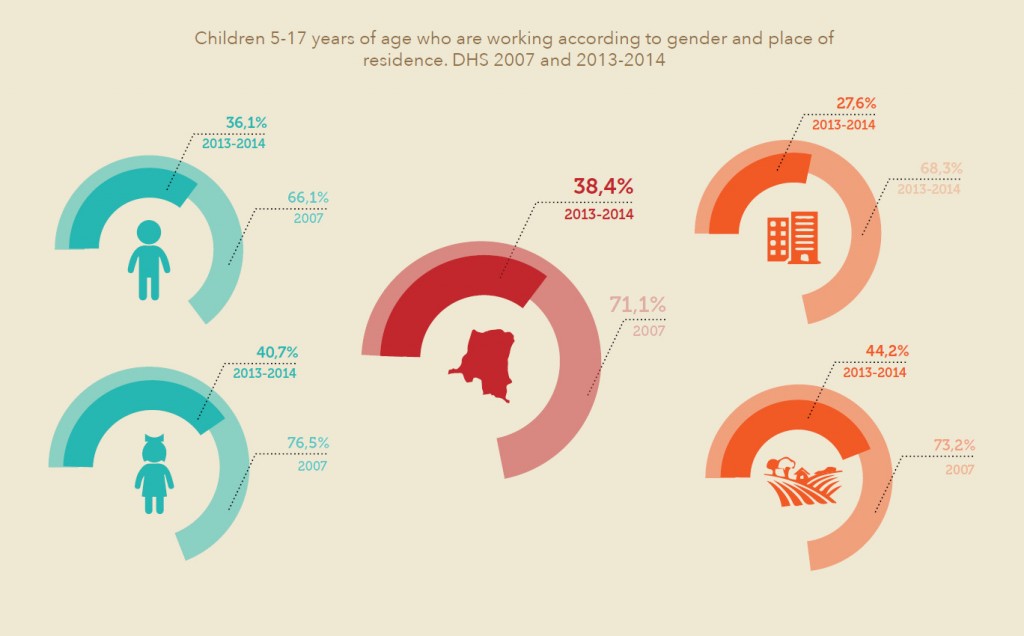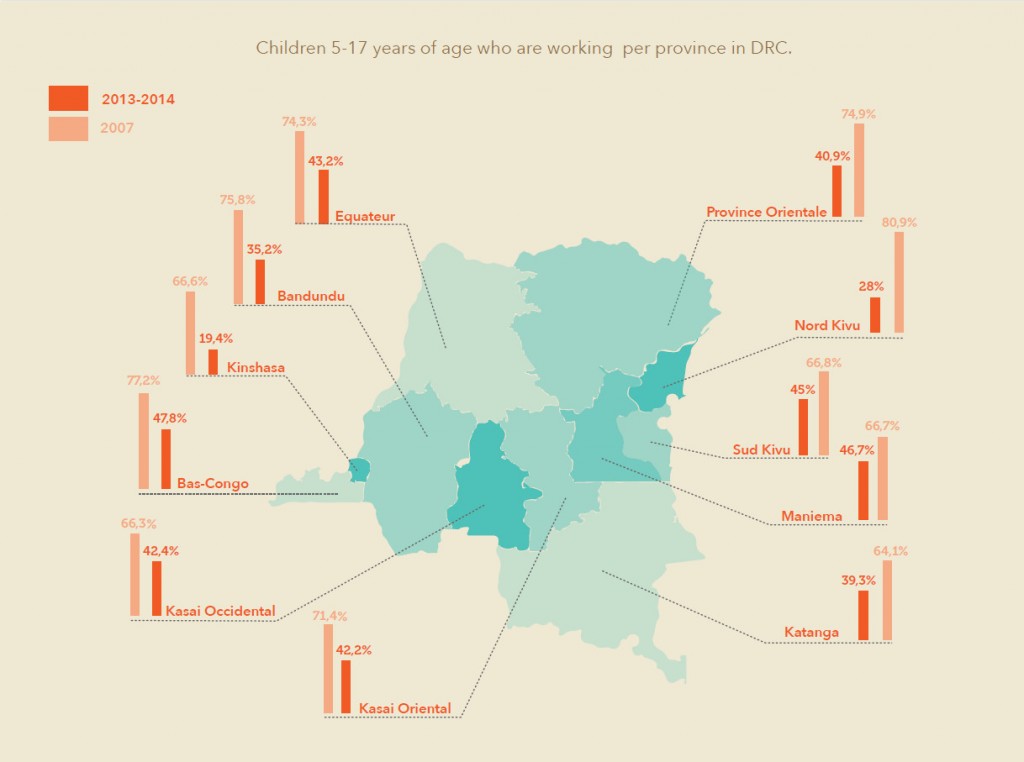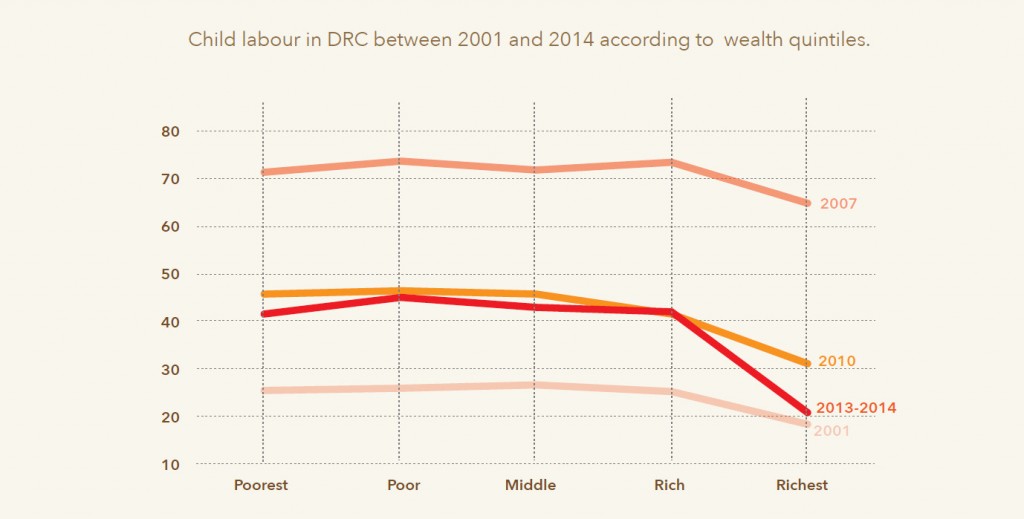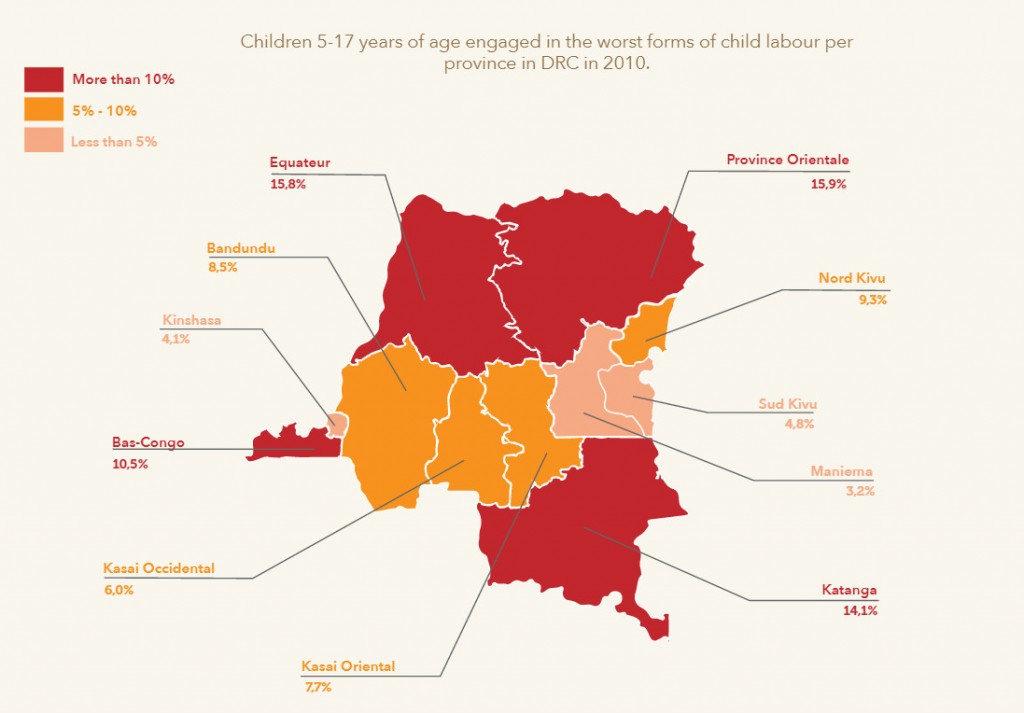Democratic Republic of the Congo: Le travail des enfants en RDC : chiffres clés
BEST OF 2016 – Child labour in DRC is a significant problem but a lot of progress has been made! Here are some key figures concerning child labour in DRC.
Child protection
It is every child’s right to be protected, and this protection is guaranteed by the Convention on the Rights of the Child (CRC). According to the CRC:
“States Parties recognise the right of the child to be protected from economic exploitation and from performing any work that is likely to be hazardous or to interfere with the child’s education, or to be harmful to the child’s health or physical, mental, spiritual, moral or social development.“
In the DRC, children can often be introduced, at school or by their parents, to certain tasks necessary for their future life. From a very early age, they are taught to develop their sense of creativity, the appetite for work or a sense of their responsibilities within the family.
However, work that is too heavy for the child is prohibited. All children from 5 to 17 years old must be protected from tasks which could put them at risk, be harmful to their health or their physical or moral development, or interfere with their education.
Child labour in DRC
In 2007, the Demographic and Health Survey revealed that about 3 in every 4 children (71%) aged 5-17 were working. Today, this figure has declined dramatically: fewer than 2 children in 4 (38%) are now working. The extent of child labour has fallen by 46% in 7 years.
Furthermore, children who are involved, to an excessive extent, in household tasks (4 hours or more per day), now represent only 6%, compared to 11% in 2007.
If we compare the extent of child labour between 2007 and 2013/2014 according to area of residence and sex, we see that the figures have fallen in all categories:
Amongst girls, for example, the proportion working fell from 77% in 2007 to 41% in 2014. For boys, the figure fell from 66% to 36% for the same period. However, we should note that most of the children who work are girls: the 2013-2014 DHS report shows that 41% of them are girls and 36% boys.
Child labour by province
The map below helps us to appreciate that this downward trend in the percentage of working children is found in all provinces. Nevertheless, the degree of reduction varies from one province to another.
The greatest fall in the figures from 2007 to 2014 occurred in Kinshasa and Nord Kivu provinces.
Child labour by family poverty
This graph shows that, as we might expect, many more poor children than rich have to work or take part in excessive economic activities.
Indeed, we can see that 41% of the poorest children work while only 21% of the richest do so.
The exploitation of children
Prolonged labour, particularly among children of primary school age (5-11 years), is one of the main causes of dropping out of school or exclusion. We can see that 29.6% of out-of-school children have been engaged in economic activities for at least one hour a day.
The information presented above reveals the issues relating to child labour in general. But a more serious issue is that working children in the DRC can sometimes be entrusted with tasks which are particularly dangerous and which they carry out in very bad conditions: these are known as the “worst forms of child labour“.
In 2010, the MICS survey in the DRC identified many worst forms of child labour, such as tasks linked to drug trafficking, selling water or cigarettes, harvesting seeds, begging, work in mines, etc.
The map below shows the significant extent of the worst forms of child labour, especially in Orientale Province (15.9%), Equateur (15.8%), Katanga (14.1%) and Bas-Congo (10.5%).
There is a clear disparity between rural and urban areas: children from rural areas are about 5 times as likely to be subjected to the worst forms of child labour as urban children. Children from the poorest households are also 3 times more at risk than those from the richest.
Encouraging news
But there is good news! In the DRC, the percentage of working children has declined by 46% in 7 years, in all provinces, and among both boys and girls! However, too many children still have to work, or are exploited in the worst forms of labour. Those most affected by this problem are still girls, children living in rural areas and the poorest children.
UNICEF is very committed to the fight against child labour in the DRC. Through this article, we invite the Government and all stakeholders in child protection to redouble their efforts in the fight against child labour.
All data are drawn from the two major Demographic and Health Surveys (DHS) conducted in the DRC in 2007 and in 2013-2014, and from the MICS (Multiple Indicators Cluster Survey), a national survey conducted by UNICEF DRC in 2010.
It should be noted that the MICS and DHS surveys do not use the same calculation bases for target groups. To calculate the number of working children, the MICS focused on the 5-14 years age group, while the DHS was based on the 5-17 years group. In addition, the methods of analysing the data differ, which prevents us from comparing the results.
Many worst forms of work were identified by the 2010 MICS: child carers for people with physical disabilities, guides for blind people, children forced into begging by parents, children used as bait for begging, child musicians and dancers in big cities, child witches, children employed in sex-related activities, children working as rock-breakers, children shining shoes, child millers.
Photo: UNICEF RDC 2013 Perrine Piton.
Infographics : UNICEF RDC 2015 Natalia Rodriguez.
Translated from French by Sally Axon
The Demographic and Health Survey
All datas come from the Demographic and Health Survey of 2013/2014 (in french only). The Survey was conducted by the Ministry of Planning and Monitoring of the Revolution of Modernity along with the Ministry of Public Health with support from partners like UNICEF, USAID, PEPFAR, the British cooperation, the World Bank Banque Mondiale, the Global Fund, UNFPA and the Bill & Melinda Gates Foundation.



